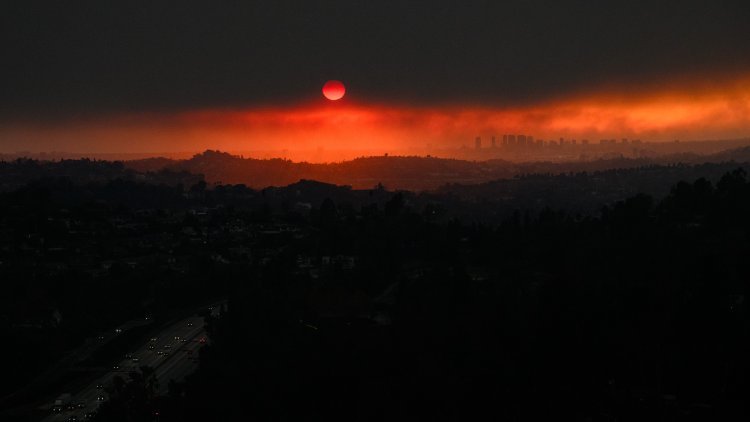The Message in the Sky Over Los Angeles
What it means to go from smog to smoke

For nearly as long as Los Angeles has been a city, the sky above it has changed colors, for short and long spells, at times portending doom. It happened again this week. Winds that would not be out of place in a hurricane roared down the western slopes of the San Gabriel Mountains toward the city. Fires ignited in the eastern chaparral foothills and along the Malibu coast. With blithe cruelty, they sprinted across the landscape, burning through thousands of homes, erasing whole family histories. In some places, they oranged the sky, and in others, they turned it beige-gray. Angelenos have by now become accustomed to spotting smoke and ash overhead during the fire season that runs from summer into fall, but not in January. To see the sun so diminished, so pale and sickly in the midwinter sky, was unnerving. It seemed like a message.
The sky over L.A. has previously contained signs, and people had the good sense to heed them. Before water from the Owens Valley was brought to L.A., and Hollywood studios began to line its boulevards, the city was dominated by more straightforwardly industrial industries. In 1903, the local oil refineries and brickyards poured so much sun-dimming smog into the sky that people thought they were experiencing an unpredicted eclipse. Steel for the Second World War was forged in L.A.’s foundries. New bombers rolled off the city’s assembly lines, and new armadas floated out of its shipyards, toward the Pacific front. People moved there from all across the world, and many bought cars. Gigantic toxic clouds started settling onto the skyline with some regularity. Some reeked of chlorine. One was mistaken for a Japanese chemical attack.
As the mid-20th century wore on, the L.A. sky began to occupy the place in the global imagination that New Delhi’s does today: It became the patch of atmosphere where one could most readily observe modernity’s drawbacks. Its mere name conjured an image of the towers downtown, massed together like giant trees but wreathed in something much less holy than a forest’s mist.
Other cities around the planet had heavy industries and daily traffic jams, but L.A.’s geography furnishes its sky with a long memory. The basin that surrounds the city almost seems designed to trap smoke; it is bordered on three sides by hills and mountains, which corral pollutants. The ocean that runs along its western edge makes things worse by sending cool drafts of air across the landscape: over the freeways, between the skyscrapers downtown, and east into the sprawl. This doesn’t mix well with the warmer air higher up in the atmosphere, and the oil-and-water dividing line between the two forms an invisible ceiling, keeping smog or smoke from drifting easily away.
[Read: It’s time to evacuate. Wait, never mind.]
People like me who grew up in Southern California didn’t like the smog. They didn’t like that it obscured the peaks of the San Gabriels. They didn’t like feeling tears forming in the corners of their eyes when they stepped outside. They didn’t like to breathe it in, and they especially didn’t like running their kids to the hospital during a midnight asthma attack. At one point, local inventors wanted to place enormous fans atop the surrounding peaks to blow it all away.
City officials sensed the public’s discontent. They had begun fighting air pollution, in earnest, in the 1950s. Industries fought them at nearly every turn, but over time, they were able to police the local refineries more closely. Some open-air incinerators stopped operating at the dumps. Lead came out of gasoline. California set the most restrictive national standards for air pollution. Thanks to L.A.’s geography, postwar population boom, and unrepentant embrace of the automobile, the city still ranks among the smoggiest in America, but its sky has become somewhat cleaner than it used to be—so long as a fire isn’t burning nearby.
The wildfire smoke that has hovered above Angelenos all week is as toxic as smog, if not more so. It’s shot through with bits of black carbon, mineral dust, and trace metals. Many of these particulates are 30 times smaller in diameter than a human hair; that’s small enough to penetrate deep into your lungs and into your bloodstream. In part to keep kids from breathing them in, the Los Angeles Unified School District closed all of its schools on Thursday and Friday. Even the Lakers, who had a game scheduled for Thursday night, were told to stay home.
Sky-oranging fires weren’t so alarming when they loomed over L.A. a few decades ago. They were rarer back then, more akin to whims of nature, like earthquakes. They didn’t suggest a new way of living on the landscape. But as human beings have heated up the planet’s atmosphere, the fires have become more regular. They have spilled out of their usual season, undoing many of those hard-fought gains in air quality, not just in California, but up and down the West Coast, and soon maybe farther afield. A message is once again flashing down from L.A.’s sky, but this time, it is one that the whole world must see. This time, it will take more than a few local law changes to clear it away.
What's Your Reaction?




















